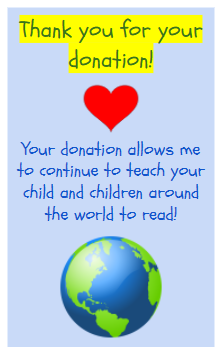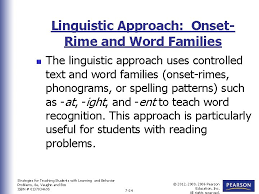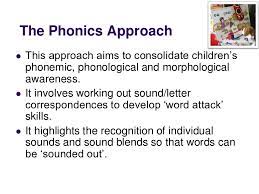What Are the Common Methods to Teaching Reading
 VectorStock Prototype
VectorStock Prototype
Different Approaches to Reading Instruction
The Guided Reading Approach
| ReadingTask Emphasized | Comprehension – understanding the meaning of the printed words. Students are directly taught strategies for both decoding and comprehension, emphasizing comprehension. |
| Motivational Approach | Increased proficiency in reading and comprehending texts using diverse strategies. Books at all levels are inviting and engaging. |
| Decoding Arroyo | Analytic – emphasis on context clues, structural analysis, and configuration clues and Constructed – begins with individual speech sounds and builds into words. Students are taught a variety of strategies to decode. |
| Story Content | Stories are interesting and increment in length and difficulty every bit the levels increase from A-Z. Students read Real literature, even in kindergarten. |
| Vocabulary Option | Words selected to exist taught generally Tier 2 words. Thesewords appear in a wide variety of texts and mature language users' written and oral language. |
| Vocabulary Difficulty | Words whose meanings the children are most probable to know are considered easiest; words non in their speaking vocabularies are considered most difficult. In many cases, vocabulary is pre-taught if the words cannot be figured out in context. Words with the near common spelling patterns (CVC, CVCe) are considered easiest; inconsistent and irregular spelling patterns are the nigh difficult. |
| Fashion of Response | Whisper and silent reading are emphasized over oral reading. Lots of book discussions rather than interrogation. |
| Structure and Abyss | Considered a complete program, but there is no formal guide; it is teacher-developed. I recommend reading the Cafe book by Gail Boushey and Joan Moser and exploring Fountas and Pinnell's materials. |
Guided reading involves using leveled reading materials with back up. Guided reading lessons allow teachers to work with students in small groups with a mutual need. Assessments, such every bit the Developmental Reading Cess 2, running records, and breezy reading inventories give teachers and parents information.
The goal of guided reading is to develop independent readers by instruction students to internalize reading strategies. Therefore, a guided reading lesson should focus on just one strategy for several lessons until the pupil has mastered information technology and can articulate it. 12 Comprehension Strategies and Strategy Objectives for Teachers tin can assist you!
According to Gail Boushey and Joan Moser of the Buffet Book, in that location are 5 goals to accomplish in guided reading:
- CAFE ~ C is for Comprehension.
- A is for Accuracy.
- F is for Fluency.
- E is for Expanding Vocabulary.
Within each goal are strategies to focus on until the student has mastered and internalized them. Again, Ever have the students clear the strategies they are using. I HIGHLY recommend these Complimentary Buffet Strategies cards. Teachers should use the gradual release of responsibility model in guided reading lessons.
Guided reading groups are very fluid, frequently changing based on need.
In guided reading groups, students read at their instructional level, which means that the books provide a moderate challenge. In addition, readers are grouped with students of similar abilities, needs, and strengths. Thus, education is tuned to the needs of the particular students.
Guided reading instruction should be fun and engaging for readers.
—————————————————————————————-

The Sight Discussion Approach
The Sight Discussion Approach is the old basal readers from the '70s and '80s ~ the big textbook with the corresponding workbook such equally Dick and Jane.
| ReadingTask Emphasized | Comprehension – discovering the meaning of printed words. |
| Motivational Approach | Enjoyment of the story content and its relationship to the children'due south ain lives. |
| Decoding Approach | Analytic – emphasis on context clues, structural assay, and configuration clues. |
| Story Content | Stories are related by a cardinal grouping of characters involved in typical childhood experiences. |
| Vocabulary Choice | Words are selected based on their frequency of use by typical children in each age group. |
| Vocabulary Difficulty | Words whose meanings the children are most probable to know are considered easiest; words not in their speaking vocabularies are considered most difficult. |
| Mode of Response | Silent reading is emphasized over oral reading; there is a low corporeality of writing. |
| Structure and Abyss | Normally offered every bit a complete program including a detailed teacher'due south guide and many supplementary materials. |
—————————————————————————————-
The Linguistic Approach
These are predictable stories; patterns can be seen in words and stories.
| ReadingTask Emphasized | Decoding – translating printed words into spoken language. |
| Motivational Approach | Increased skill in reading words. |
| Decoding Arroyo | Analytic – begins with the spelling pattern of the whole discussion; students discover relationships between spelling patterns and voice communication sounds. |
| Story Content | Stories are related by the spelling pattern of words. |
| Vocabulary Choice | Words are selected based on their spelling pattern. |
| Vocabulary Difficulty | Words with the most common spelling patterns (CVC, CVCe) are considered easiest; inconsistent and irregular spelling patterns are the well-nigh hard. |
| Fashion of Response | Emphasis on oral reading; generally low amount of writing. |
| Structure and Completeness | Highly structured and marketed as a consummate reading plan. |
—————————————————————————————-
The Language-Feel Approach
This is based on the child'south language. Preschool, kindergarten, and grade one teachers tin can easily add this to their day.
| ReadingTask Emphasized | Comprehension – understanding the meaning of the printed word. |
| Motivational Approach | Enjoyment of story creation and story content. |
| Decoding Approach | Analytic – begins with the whole word and gradually works dorsum to messages and syllables; emphasis is on context clues with other decoding skills. |
| Story Content | The students write stories based on their shared experiences. |
| Vocabulary Selection | No selection; vocabulary is based on the students' spoken linguistic communication. |
| Vocabulary Difficulty | Words most common in the children'south speaking vocabulary are considered easiest; those non in the children'due south speaking vocabulary are considered most hard. |
| Fashion of Response | Silent reading beginning, then oral with a high amount of writing. |
| Structure and Completeness | Considered a consummate programme with a low amount of structure. |
—————————————————————————————-
The Multisensory Approach
Wilson and Orton-Gillingham are multisensory programs used in special didactics. Students learn using more than one sense at a fourth dimension. Multisensory involves the use of visual, auditory, and tactile pathways. Learning becomes faster and easier when several parts of the brain record the same fact.
| ReadingTask Emphasized | Decoding – interpret letter of the alphabet symbols into oral communication sounds. |
| Motivational Arroyo | Increased skill in decoding printed words. |
| Decoding Approach | Synthetic – begins with individual speech sounds and builds into words with a strong emphasis on motor feedback. |
| Story Content | Stories are related by the sounds and motor patterns existence learned. |
| Vocabulary Choice | Words are selected by their phonic regularity and the phonics rules they follow. |
| Vocabulary Difficulty | Phonetically regular words with short vowel sounds are the easiest, while phonetically irregular words are the nearly hard. |
| Style of Response | Emphasis on writing and other motor activities and oral reading. |
| Structure and Completeness | Highly structured programs frequently paired with other reading programs. |
—————————————————————————————-
T he Phonics Approach
Oftentimes these stories lack any sense, depth, or involvement. How long can yous read almost a "fat true cat that sat on a mat?" 🙂
| ReadingTask Emphasized | Decoding – translate letter symbols into voice communication sounds. |
| Motivational Approach | Increased skill in decoding printed words. |
| Decoding Approach | Synthetic – begins with individual speech sounds and builds into words. |
| Story Content | Stories are based on the sounds of the words being learned. |
| Vocabulary Choice | Words are selected for their phonic regularity and phonics rules. |
| Vocabulary Difficulty | Phonetically regular words with brusque vowel sounds are considered easiest, and phonetically irregular words are the virtually difficult. |
| Mode of Response | Emphasis on oral reading (some programs require a moderate corporeality of writing). |
| Construction and Completeness | Varies with the program from very structured to more teacher-developed. |
 A Discussion doc of this page is bachelor with a $10 donation for my website maintenance fees. No graphics due to copyright laws. Give thanks you!
A Discussion doc of this page is bachelor with a $10 donation for my website maintenance fees. No graphics due to copyright laws. Give thanks you!

Copyright 08/18/2012
Edited on 02/24/2022
Copyscape alerts me to duplicate content. Please respect my work.

Source: https://www.mrsjudyaraujo.com/different-approaches-to-teaching-reading/





Postar um comentário for "What Are the Common Methods to Teaching Reading"